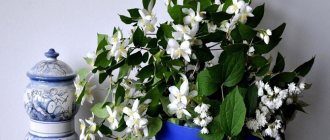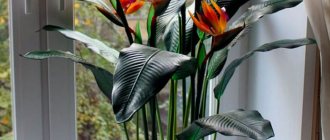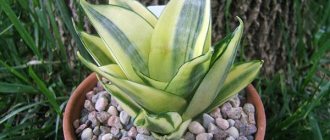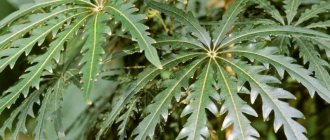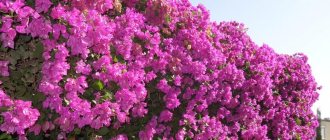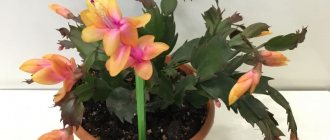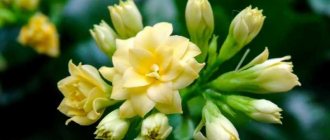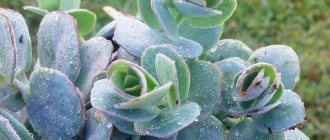Alpinia is a herbaceous bush-like flowering perennial native to the hot tropical and subtropical regions of Southeast Asia, where it actively grows almost along the entire Pacific coast. In our latitudes, the plant feels best in greenhouses, where it is grown commercially for cutting into bouquets, but with good care, alpinia can be grown at home. This flower does not overwinter in Russian gardens, but if wintered in a warm room, it can serve as a seasonal decoration for a personal plot.
Landing, transplant
Alpinia prefers light soils: a mix of leaf soil, humus, peat in a one-to-one ratio and sand (0.5). The plant is placed in a wide, shallow pot, with drainage (expanded clay, pebbles, etc.) placed on the bottom. From April until mid-autumn, alpinia needs feeding twice a month, alternating organic fertilizers with mineral ones. In winter, feeding stops.
Transplantation is carried out at the very end of winter or at the beginning of spring using the transshipment method. The earthen lump is carefully removed from the old pot so as not to damage the roots, and placed in a larger container.
The difference between the sizes of the two pots should be small - up to 1 cm. Young alpinias are replanted every year, then as needed.
Diseases and pests
Alpinia does not tolerate lack of moisture. If there is insufficient watering, the plant withers and dries out. The culture has a strong immunity to infectious diseases. The flower can be affected by pests:
- aphid;
- spider mite
Table 4. Pests affecting alpinia and methods of controlling them.
As a preventive measure, indoor plants can be sprayed with infusions of garlic, onions, and a weak solution of brilliant green with milk. Bushes on which pests are found should be wiped with a damp sponge dipped in an infusion of citrus fruit peels.
You can get rid of insects using a solution of laundry soap (50 g per liter of water). The leaves are sprayed with the product, then the plant is covered with polyethylene for a day. After this, the solution is washed off from each leaf with clean warm water. After this, the procedure is repeated again.
Rice. 6 Spider mite on a leaf.
Temperature, watering
Alpinia is light-loving; in good light it produces more flower stalks, but in summer it is harmed by direct sunlight. A comfortable temperature for it does not exceed +25 degrees in summer, in winter it is cooler, up to +18. In cold weather, it is better for the plant to be on the south side. Alpinia is an individualist, she does not like neighbors nearby, there should be free space around her.
The soil should be moist from spring to autumn. Water the alpinia with soft, settled water. It is convenient to place the pot with the plant in a tray with small pebbles and water. Additionally, spray the leaves with water at room temperature. Every week the leaves should be wiped from dust and washed with warm water in spring and summer.
Due to lack of moisture and very dry air in the apartment, alpinia leaves can dry out and their tips darken. This is a sign of a weakened plant; spider mites can settle on it.
Feeding and fertilizers
Alpinia grows very quickly. During the growing season, it requires fertilizers containing nitrogen and phosphorus. For this purpose, you can use complex mixtures of factory production intended for indoor flowers.
You can feed houseplants with infusions of cut herbs, onion peels and eggshells. They are made according to the same scheme:
- half fill a three-liter jar with raw materials;
- fill the container to the brim with boiling water;
- leave to infuse for 2-3 days;
- the infusion is diluted with clean water in a ratio of 1 to 10;
- the solution is poured under the root of the plant.
In rural areas, where there is poultry, chicken manure is used to prepare fertilizer. One liter of dry product is diluted in a bucket of water. They insist for at least a day. The product is diluted 1 to 10 and used for root feeding.
During the budding period, you can use the following for feeding:
- castor oil (1 tsp per 1 liter of water);
- "Veriohumus" solution;
- infusions of garlic, onion;
- lake silt;
- drugs "Pokon", "Agricola".
Tropical indoor flowers are fed following several rules:
- the solution of complex preparations is made strictly according to the instructions, avoiding overdose;
- fertilizing is carried out only during the period of active growth and flowering;
- In winter, complex mineral preparations are not added to the soil; the foliage can be sprayed with infusions of garlic and onions;
- do not allow chemical fertilizers to get on the above-ground part of the flower;
- for foliar feeding, use only those mixtures that are intended for this purpose and this is mentioned in the attached instructions;
- for young seedlings, the nutrient solution is diluted twice as weakly as for adult samples;
- during the period of active growth, nitrogen and phosphorus are added; for the flowering period, fertilizers containing potassium are intended;
- nutrient solutions are poured onto moist soil, otherwise the root system can be burned;
- Fertilizers are used taking into account the compatibility of microelements.
Table 2. How to properly apply fertilizers.
Important . Universal concentrated fertilizers contain the entire range of microelements; for this reason, they are ineffective when plants lack a specific substance for growth and flowering.
Table 3. Amount of substance in grams per 10 liters of water.
| Period | Ammonium nitrate | Potassium salt | Superphosphate |
| active growth of young plants | 10 | 15 | 15 |
| budding | 20 | 15 | 25 |
| bloom | 20 | 10 | 25 |
Reproduction
Alpinia is propagated in the spring when it is transplanted. The rhizome is cut into separate fragments, each placed in a separate pot, the sections should be sprinkled with fine charcoal. The soil consists of turf, humus and sand in equal proportions.
You can grow alpinia from seeds. Only the seeds quickly become inactive; they must be used as soon as collected. The seed is planted in January in the same mixture as rhizome fragments, the temperature for germination is from +22 degrees. Watering is constant; emerging sprouts need to be sprayed and ventilated.
general description
Alpinia belongs to the herbaceous representatives of the Ginger family. This is a perennial, which, like all ginger plants, has a strongly fragrant branched rhizome, colored red-brown and developing in a horizontal direction.
Each of its branches produces a separate strong and densely leafy stem, of which as a result there are up to 3-4 dozen in one plant specimen. The lance-shaped leaves sit tightly on the stem and, when broken, also emit a characteristic odor. The flowers are collected in racemose inflorescences of fairly large sizes, which, depending on the variety, can be directed vertically upward or hang downward. The petals of the small flowers are white, yellow or various shades of red.
Alpinia rhizome has medicinal properties, and is also widely used by the natives of Asian countries and the islands of Oceania as a seasoning.
Alpinia as a medicine
Parts of the plant, mainly its rhizome, contain various flavonoids, essential oils, and a small amount of tannins.
In folk medicine, alpinia (Alpinia galanga) is used internally:
- for intestinal infections
- bronchitis
- rheumatism
- type 2 diabetes
- allergic rhinitis
- to improve digestion
A tincture is prepared from the rhizome for external use for various fungal diseases.
Eastern medicine recommends alpinia seeds for
- malaria
- cholera
- toothache
- various gastrointestinal diseases
The seeds contain ingredients that help restore salivation, gas secretion, appetite, relieve headaches, and seasickness. Alpinia is also believed to help strengthen the immune system.
Kinds
The genus Alpinia has a huge variety of species of these plants. The more common ones are the following:
Alpinia purpurata . The height of the plant is about 2 m. The flowers are white, bordered by red bracts.
Alpinia sanderae (Alpinia vittata)). The plant is low, multi-leaved. The height reaches 60 cm. The leaves are linear, sessile, green. Their characteristic feature is oblique white stripes. The flowers are crimson in color, collected in an apical panicle.
Alpinia officinalis (Alpinia officinalis). The plant is large. The leaves are arranged alternately, sessile, up to 30 cm long. The flowers are collected in a short apical spike, white with red apical stripes.
Alpinia zerumbet. The plant is large. The height of the plants reaches 3 m. The leaves are narrow at the base, widening to the edges, and lobed in shape. The flowers are yellow-white in color, collected in drooping clusters. Their length reaches 30 cm.
Alpinia galanga . The height of the plant reaches 1.5 m. The leaves are entire, up to 30 cm long, lanceolate in shape. The flowers are white, tightly collected in a cone-shaped brush.
Photo of Alpinia plant
Dinaric race
1 – Dinaran + Nordid 2-Dinaran
1- Dinaric with Nordic influence, 2- predominantly Dinaric
1- Dinaran + Nordid 2 – Dinaran
Dinaran
Dinaran
predominantly Dinaric
7. Sudeten race (Uraloids/Lappoids)
1- Uraloid/Lappoid, 2- Uraloid/Lappoid+Nordid
2 Uraloid/Lappoid – Eastern Baltid
1.2 – predominantly Uraloids/Lappoids with Nordic influence
predominantly uraloid/lappoid
8. Western Asian and Orientalid races
Central Asian race (monoloid) + Dinaric or West Asian + Central Asian race 1 - West Asian 2 - West Asian, or predominantly West Asian 1 - West Asian 2 - predominantly West Asian
1.2 – predominantly Western Asians
1,2- orientalids 1,2 – orientalids 1,2 – predominantly orientalids
1 – Orientalid+Nast Asian 2- Orientalid with Near Asian influence
9. Maps and other materials
.
1 The skull is oblong in shape with a cephalic index of 72.9.
2. Short skull with cephalic index 88.3.
1. Narrow face. (Facial index 93.5).
2. Wide face. (Facial index 83.3)
Map I. Blue-eyed blondes (based on Parsons research)
Map II. Brown-eyed brunettes (according to Parsons research)Map III. Dark pigmentation index (according to Parsons research) Map IV. Cephalic index (based on Parsons research)
MapV. The spread of “darkness” in Central Europe
After the so-called Virchowschen study of schoolchildren, which was carried out in 1874-77 in the countries indicated by the map and extended in the German Empire to 10 million schoolchildren. As “blonds” it was necessary to accept in the lists: children with fair skin, blond hair and blue eyes; as “dark”: Children with dark skin, dark brown or black hair and brown eyes. The percentage of German-speaking “blonds” in Germany is 31.8%, in Austria 19.7%, in Switzerland 11.1%; The percentage of German-speaking “dark-skinned” people in Germany is 14.05%, in Austria 23.17%, in Switzerland 25.7%. An Italian army survey in 1898 found 66.3% in Italy, a Swedish army survey in 1926 found 0.9% “dark” in Sweden. Light colors may indicate Nordic, Falish and East Baltic heredity, dark colors indicate the heredity of dark European races, possibly a slight influence of extra-European races.
Map VI by Bernhard Struck – “light” and “dark”
Map VII by Bernhard Struck - height Map VIII by Bernhard Struck - cephalic index
Map IX by Bernhard Struck – facial index
Classification by E. Hooton
American scientist E. Hooton in the work Up from the Ape
(1946) divided the white or Caucasian race into the following types:
- Mediterranean type Upper Paleolithic, mainly in the British Isles
- Iranian plateau type
- Classic Mediterranean, in eagle-nosed and straight-nosed versions
He also identified composite types, mostly white:
- Australian (archaic variant of the white race + Tasmanian + Melanesian) Murray, with a predominance of the white element
- Carpentarian, with a predominance of Melanesian
- Tasmanoid
- Classic Indo-Dravidian, leaning toward the classic Mediterranean type: northern India

